torque OLDSMOBILE SILHOUETTE 1996 Owners Manual
[x] Cancel search | Manufacturer: OLDSMOBILE, Model Year: 1996, Model line: SILHOUETTE, Model: OLDSMOBILE SILHOUETTE 1996Pages: 372, PDF Size: 19.39 MB
Page 98 of 372

I
It can be dangerous to leave your vehicle with
the engine running. Your vehicle could move
suddenly
if the shift lever is not fully in PARK (P)
with the parking brake firmly set. And, if you
leave the vehicle with the engine running, it could
overheat and even catch fire. You or others could
be injured. Don’t leave your vehicle with the engine running unless
you have to.
If you have to leave your vehicle with the engine
running, be sure your vehicle is in PARK (P) and your
parking brake is firmly set before you leave
it. After
you’ve moved the shift lever into the PARK
(P)
position, hold the regular brake pedal down. Then, see if
you can move the shift lever away from PARK (P)
without first pulling it toward you.
If you can, it means that the shift lever wasn’t fully
locked into PARK (P).
-1
If you are parking on a hill and you don’t shift your
transaxle into PARK (P) properly, the weight
of the
vehicle may put too much force on the parking pawl in
the transaxle. You may find it difficult to pull the shift
lever out of PARK
(P). This is called “torque lock.” To
prevent torque lock, set the parking brake and then shift
into PARK (P) properly before you leave the driver’s
seat.
To find out how, see “Shifting Into PARK (P)” in
the Index.
When you are ready to drive, move the shift lever out
of
PARK (P) before you release the parking brake.
If torque lock does occur, you may need to have another
vehicle push yours
a little uphill to take some of the
pressure from the transaxle,
so you can pull the shift
lever out of PARK (P).
ProCarManuals.com
Page 242 of 372
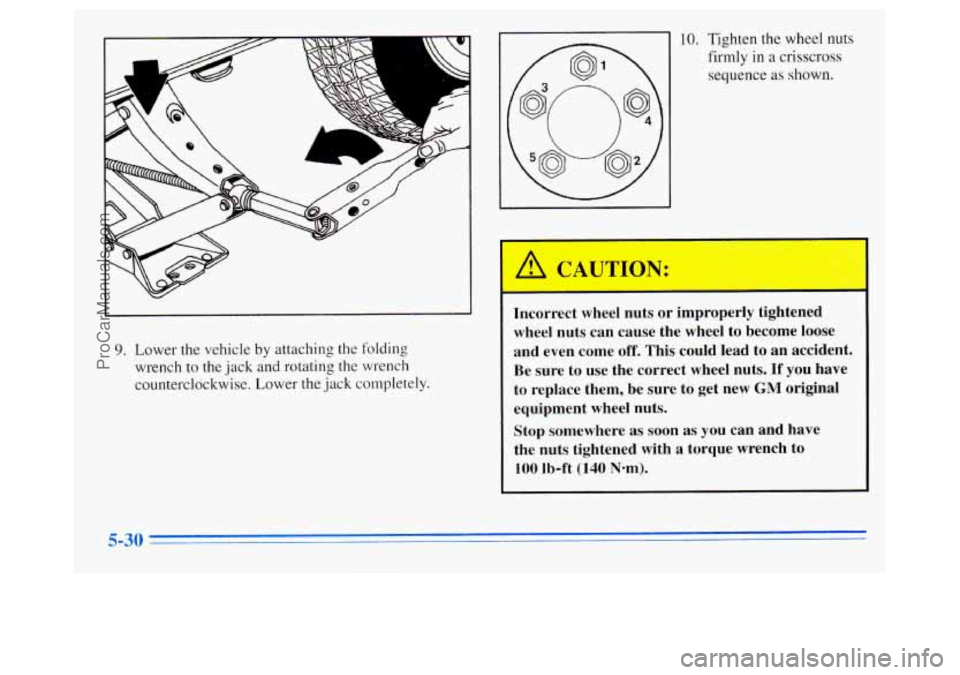
h
A
9. Lower the vehicle by attaching the folding
wrench to the jack and rotating the wrench
counterclockwise. Lower the jack completely. 10.
Tighten the wheel nuts
firmly in a crisscross
sequence as shown.
Incorrect wheel nuts or improperly tightened
wheel nuts can cause the wheel to become loose
and even come off. This could lead to an accident.
Be sure to use the correct wheel nuts.
If you have
to replace them, be sure to get new
GM original
equipment wheel nuts.
Stop somewhere
as soon as you can and have
the nuts tightened with a torque wrench to
100 lb-ft (140 N-m).
ProCarManuals.com
Page 243 of 372
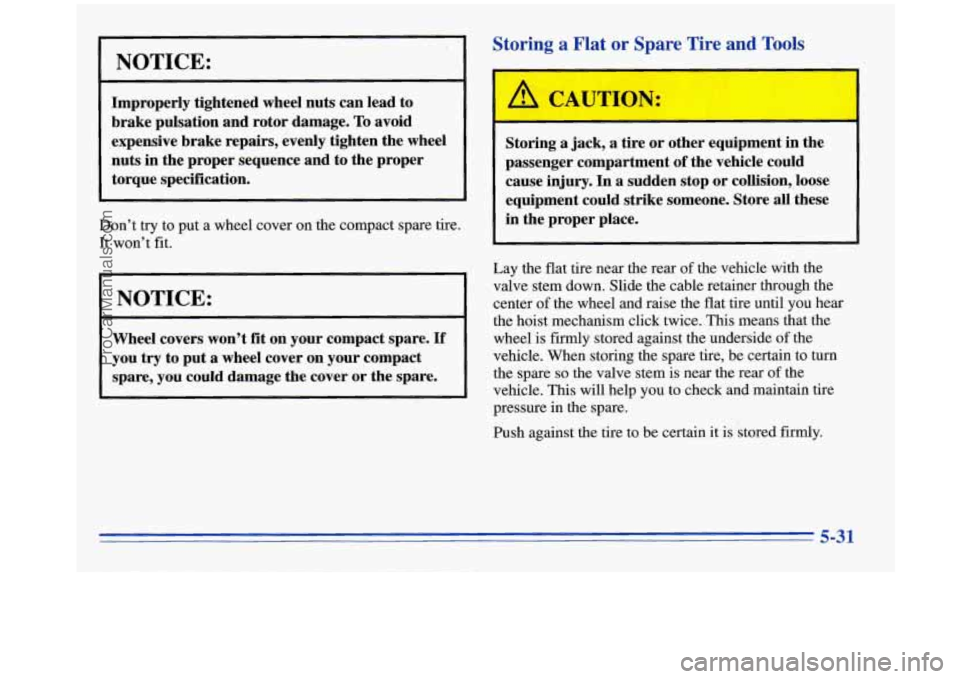
NOTICE:
Improperly tightened wheel nuts can lead to
brake pulsation and rotor damage.
To avoid
expensive brake repairs, evenly tighten the wheel
nuts in the proper sequence and to the proper
torque specification.
Don’t try to put
a wheel cover on the compact spare tire.
It won’t fit.
NOTICE:
Wheel covers won’t fit on your compact spare. If
you try to put a wheel cover on your compact
spare, you could damage the cover or the spare.
Storing a Flat or Spare Tire and Tools
Storing a jack, a tire or other equipment in the
passenger compartment of the vehicle could
cause injury. In
a sudden stop or collision, loose
equipment could strike someone. Store all these
in the proper place.
Lay the flat tire near the rear of the vehicle with the
valve stem down. Slide the cable retainer through the
center of the wheel and raise the flat tire until you hear
the hoist mechanism click twice. This means that the
wheel is firmly stored against the underside of the
vehicle. When storing the spare tire, be certain to turn the spare
so the valve stem is near the rear of the
vehicle. This will help you to check and maintain tire
pressure
in the spare.
Push against the tire to be certain it is stored firmly.
5-31
ProCarManuals.com
Page 273 of 372
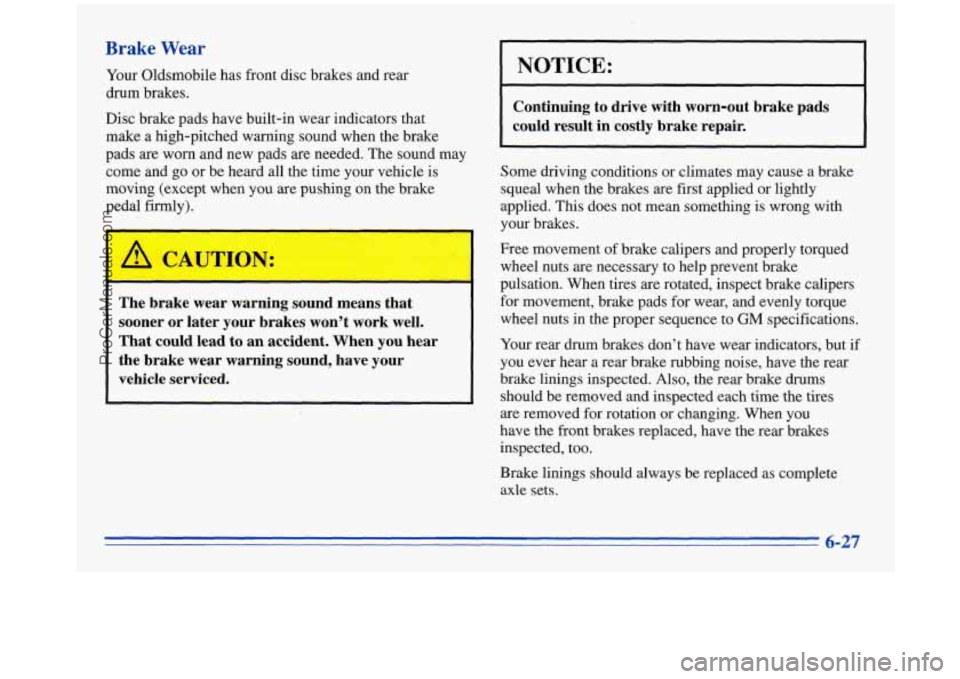
Brake Wear
Your Oldsmobile has front disc brakes and rear
drum brakes.
Disc brake pads have built-in wear indicators that
make a high-pitched warning sound when the brake
pads are
worn and new pads are needed. The sound may
come and go or be heard all the time your vehicle is
moving (except when you
are pushing on the brake
pedal firmly).
The brake wear warning sound means that
sooner or later your brakes won’t work well.
That could lead to an accident. When
you hear
the brake wear warning sound, have your
vehicle serviced.
NOTICE:
Continuing to drive with worn-out brake pads
could result in costly brake repair.
Some driving conditions or climates may cause a brake
squeal when the brakes
are first applied or lightly
applied. This does not mean something is wrong with
your brakes.
Free movement of brake calipers and properly torqued
wheel nuts are necessary to help prevent brake
pulsation. When tires are rotated, inspect brake calipers
for movement, brake pads
for wear, and evenly torque
wheel nuts in the proper sequence to
GM specifications.
Your rear drum brakes don’t have wear indicators, but
if
you
ever hear a rear brake rubbing noise, have the rear
brake linings inspected. Also, the rear brake drums
should be removed and inspected each time the tires
are removed for rotation or changing. When you
have the front brakes replaced, have the rear brakes
inspected, too.
Brake linings should always be replaced
as complete
axle sets.
6-27
ProCarManuals.com
Page 283 of 372
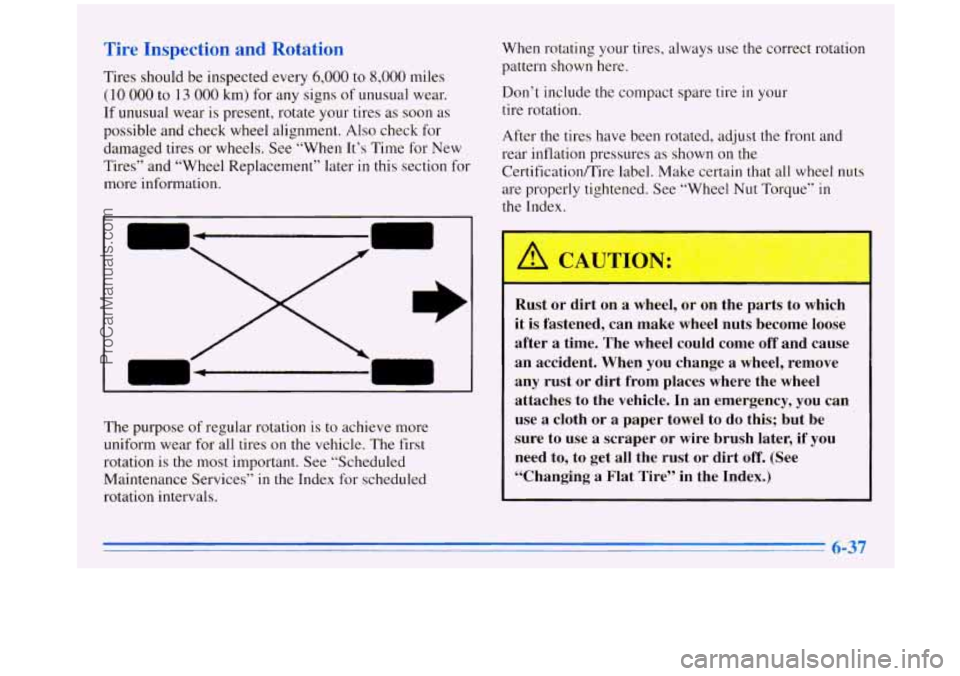
Tire Inspection and Rotation
Tires should be inspected every 6,000 to 8,000 miles
(10 000 to 13 000 km) for any signs of unusual wear.
If unusual wear is present, rotate your tires as soon as
possible and check wheel alignment. Also check for
damaged tires or wheels. See “When It’s Time for New
Tires” and “Wheel Replacement” later in this section for
more information. When rotating your tires, always use the correct rotation
pattern shown
here.
Don’t include the compact spare tire
in your
tire rotation.
After the tires have been rotated, adjust the
,. ont and
rear inflation pressures as shown on the
CertificatiodTire label. Make certain that all wheel
nuts
are properly tightened. See “Wheel Nut Torque” in
the Index.
/
The purpose of regular rotation is to achieTe 1yicsre
uniform wear for
all tires on the vehicle. The first
rotation is the most important. See “Scheduled
Maintenance Services”
in the Index for scheduled
rotation intervals.
Rust or dirt on a wheel, or on the parts to which
it is fastened, can make wheel nuts become loose
after
a time. The wheel could come off and cause
an accident. When you change
a wheel, remove
any rust or dirt from places where the wheel
attaches to the vehicle. In an emergency, you can
use
a cloth or a paper towel to do this; but be
sure to use a scraper
or wire brush later, if you
need to, to get all the rust or dirt off. (See
“Changing a Flat Tire” in the Index.)
6-37
ProCarManuals.com
Page 305 of 372
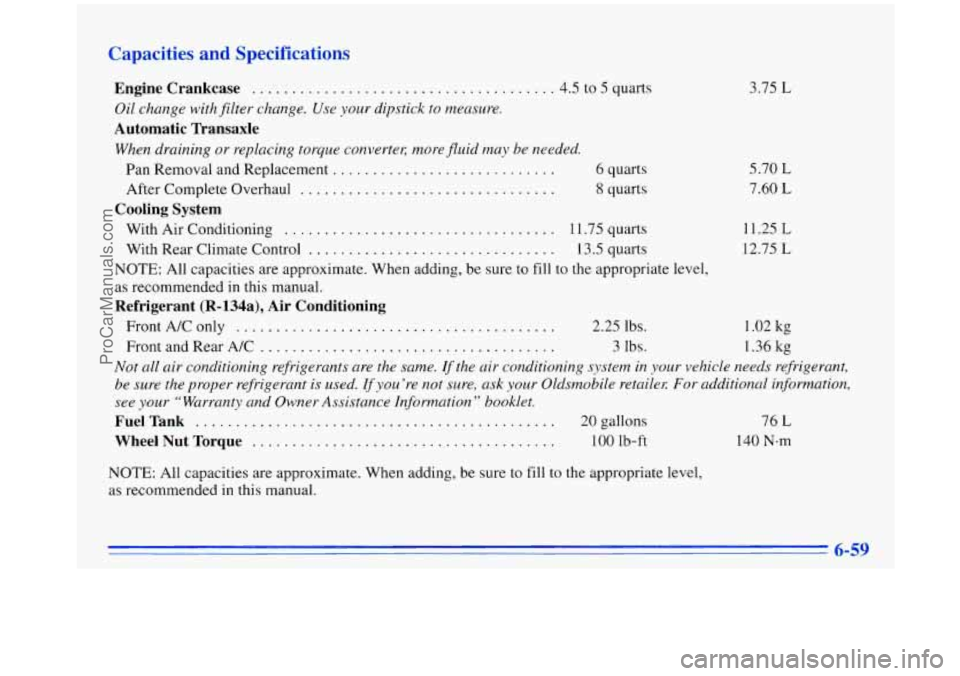
Capacities and Specifications
Engine Crankcase ...................................... 4.5 to 5 quarts
Oil change with filter change. Use your dipstick to measure.
Automatic Transaxle
When draining or replacing torque convertel; more fluid may be needed.
Pan Removal and Replacement ............................ 6 quarts
After Complete Overhaul
................................ 8 quarts
With Air Conditioning
.................................. 11.75 quarts
With Rear Climate Control
............................... 13.5 quarts
Cooling System
NOTE: All capacities are approximate. When adding, be sure to fill to the appropriate level,
as recommended in this manual.
Refrigerant (R-l34a), Air Conditioning
FrontA/Conly ........................................ 2.25 lbs. 1.02 kg
Front and Rear A/C ..................................... 3 lbs. 1.36 kg
Not all air conditioning refrigerants are the same. rfthe air conditioning system in your vehicle needs refrigerant,
be sure the proper refrigerant is used.
lfyou ’re not sure, ask your Oldsmobile retailez For additional information,
see
your “Warranty and Owner Assistance Information ” booklet.
FuelTank ............................................. 20gallons 76 L
WheelNutTorque ...................................... 100 lb-ft 140 N-m
NOTE: All capacities are approximate. When adding, be sure to fill to the appropriate level,
as recommended
in this manual. 3.75
L
5.70 L
7.60 L
11.25 L
12.75 L
6-59
ProCarManuals.com
Page 369 of 372
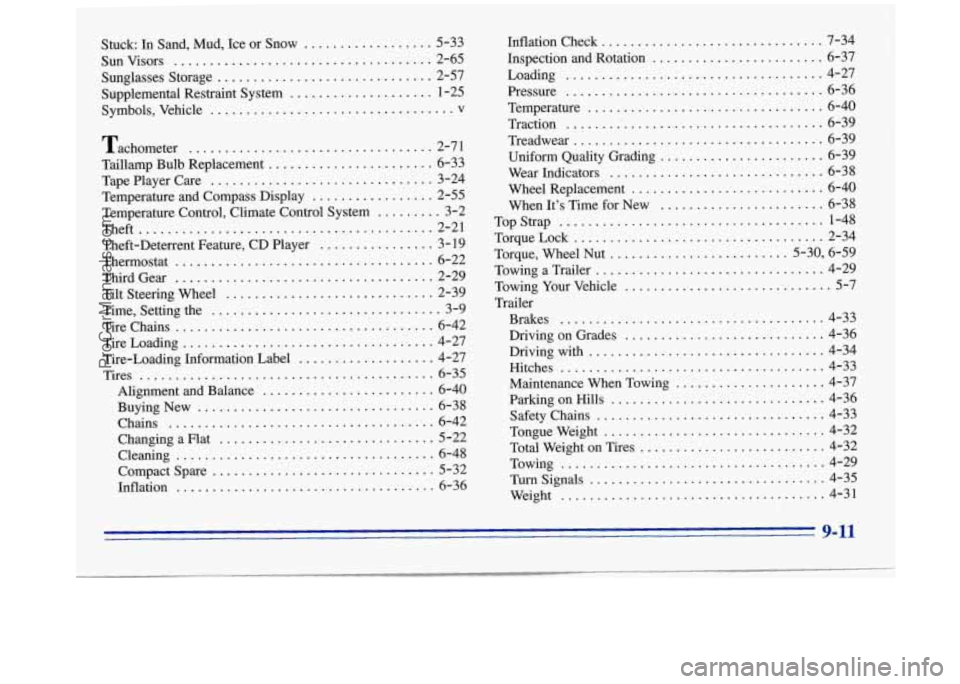
Stuck: In Sand. Mud. Ice or Snow .................. 5-33
Sunvisors
.................................... 2-65
Sunglasses Storage
.............................. 2-57
Supplemental Restraint System
.................... 1-25
Symbols. Vehicle
.................................. v
Tachometer .................................. 2-7 1
Taillamp Bulb Replacement
....................... 6-33
TapePlayerCare
............................... 3-24
Temperature and Compass Display
................. 2-55
Temperature Control, Climate Control System
......... 3-2
Theft
......................................... 2-21
Theft-Deterrent Feature, CD Player
................ 3- 19
Third Gear 2-29
Tilt Steering Wheel
............................. 2-39
Time, Setting the
................................ 3-9
Tirechains
.................................... 6-42
TireLoading
................................... 4-27
Tire-Loading Information Label
................... 4-27
Tires
......................................... 6-35
Alignment and Balance
........................ 6-40
Buying New
................................. 6-38
Chains
..................................... 6-42
ChangingaFlat
.............................. 5-22
Cleaning
.................................... 6-48
Compact Spare
............................... 5-32
Inflation
.................................... 6-36
Thermostat
.................................... 6-22
....................................
Inflation Check ............................... 7-34
Inspection and Rotation
........................ 6-37
Pressure
.................................... 6-36
Temperature
................................. 6-40
Traction
........ ' ............................ 6-39
Treadwear
................................... 6-39
Uniform Quality Grading
....................... 6-39
Wear Indicators
.............................. 6-38
Wheel Replacement
........................... 6-40
When It's Time for New
....................... 6-38
Loading
.................................... 4-27
TopStrap
..................................... 1-48
TorqueLock
................................... 2-34
Torque, Wheel
Nut ......................... 5-30. 6-59
Towing a Trailer
................................. 4-29
Towing Your Vehicle
.............................. 5-7
Trailer
Brakes
..................................... 4-33
Hitches
..................................... 4-33
ParkingonHills
.............................. 4-36
Tongueweight
............................... 4-32
Towing
..................................... 4-29
Turnsignals
................................. 4-35
Weight
..................................... 4-31
Driving
on Grades ............................ 4-36
Driving with
................................. 4-34
Maintenance When Towing
..................... 4-37
Safety Chains
................................ 4-33
Total Weight
on Tires .......................... 4-32
9-11
ProCarManuals.com